by Sarah Segall | Oct 24, 2015 | Preschool
El Olfato
This week was all about our sense of smell / el olfato. We read about different ways we use el olfato as well
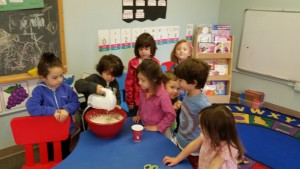
Taking turns in our baking project.
as participating in several activities where students played using this sense. The students had a great time making cupcakes. In this activity they used their sense of smell with each flavor that we used. We also worked with sequencing the steps during this activity. Another activity was for them to guess what was inside each o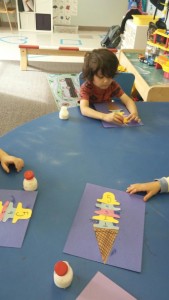 f a set of glasses using only their sense of smell/ el olfato.
f a set of glasses using only their sense of smell/ el olfato.
Letras y Números
This week we learned about letter U/ vocal u, and the number 5. Be sure to point out the letter U when you are reading. The English pronunciation of this letter is the long vowel sound /u/:u-e, use, ew /u/ as unicorn. The Spanish pronunciation stops with just the /u/ sound. (Think of this as the monkey’s favorite letter. u-u-u.)
We also incorporated our previous touch investigation with our letter U’s.
We worked with the number five doing many different activities. One activity was an ice cream cone with five ice cream flavors, counting numbers 1 thought 5, identifying groups of 5. See if your child can put together different groups of 5 items. Can they find the number 5 anywhere? On mailboxes, or house numbers during a fall walk?
Pumpkin Fun Run
The Pumpkin Fun Run was exactly that, Fun! The preschoolers who attended did a fantastic job not only at the fun run but during the walk to and from the track! They sure did get their exercise in that day!
Halloween at SWS
Students can wear their costumes on the last class before Halloween, Thursday and Friday. Please be sure not to send little pieces/props that might get lost. We will incorporate some Halloween math activities into our special day.
by Sarah Segall | Oct 24, 2015 | In The Loop
Language Arts
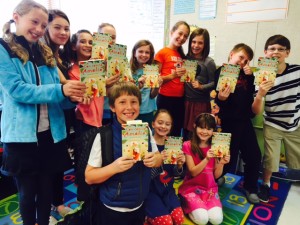 On Monday, students worked on their new spelling list which focuses on palabras esdrujulas y sobreesdujulas (ask your child to tell you about these words). Students were asked to submit their sentences on Thursday. As a class, we selected the sentences that will be part of our dictado on Tuesday and Thursday. This particular list gave us the opportunity to take a closer look at complex words/verbs, their meaning, conjugation and accurate usage. Please make sure your child practices their sentences over the weekend.
On Monday, students worked on their new spelling list which focuses on palabras esdrujulas y sobreesdujulas (ask your child to tell you about these words). Students were asked to submit their sentences on Thursday. As a class, we selected the sentences that will be part of our dictado on Tuesday and Thursday. This particular list gave us the opportunity to take a closer look at complex words/verbs, their meaning, conjugation and accurate usage. Please make sure your child practices their sentences over the weekend.
After our fun school event Corrida de calabazas, our class started working on an expository piece. We reviewed some concepts such as identifying the purpose for our writing as well as our audience, and gave examples of different informational texts. We also had a chance to review non-fiction text features. We have a fun project in mind, which I will tell you more about as it progresses.
We culminated our week with our reader’s celebration. We have successfully finished our first book club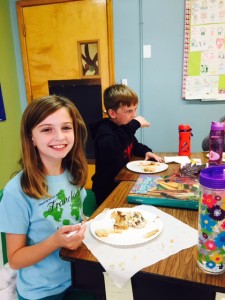 and look forward to our next one. Students have shared their ideas of possible books and we will be making a democratic decision next week!
and look forward to our next one. Students have shared their ideas of possible books and we will be making a democratic decision next week!
Oswaldo Guayasamin is a renowned Ecuadorian indigenous artist. I am very fond of his work. I wanted to share his sublime work with my students. On Friday afternoon, we looked at some of his work and interpreted some of his remarkable pieces.
Science
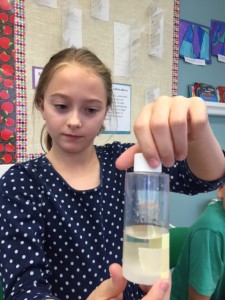 We conducted the first part of Investigation 2: Reaching Saturation. Using specific measurements, students worked on making a solution by adding salt to water until no more salt would dissolve. As we kept adding more spoons of salt into the water, we discovered that there was a limit to the amount of solid(solute) that dissolved. Even after we tried shaking the bottled very fast. We learned that when the solution has “soaked up”as much solute as it can, the solution is saturated.
We conducted the first part of Investigation 2: Reaching Saturation. Using specific measurements, students worked on making a solution by adding salt to water until no more salt would dissolve. As we kept adding more spoons of salt into the water, we discovered that there was a limit to the amount of solid(solute) that dissolved. Even after we tried shaking the bottled very fast. We learned that when the solution has “soaked up”as much solute as it can, the solution is saturated.
Math
Students worked at mastery of long division this week. We did a lot of group work, various activities and practiced how the standard algorithm is completed step by step. We will do more with this next week. As the strategies are mastered, students will be assigned more complicated tasks that will require a higher level of thinking about division.
Social Studies
In history this week we continued our studies on the Renaissance. We have learned a lot of interesting facts about this historical time! Next week we will be reading and learning more about the Renaissance and will follow that with more details about the Reformation. Our weekly vocabulary studies have done well to solidify people, places, and important inventions during the European Renaissance and Reformation time period.
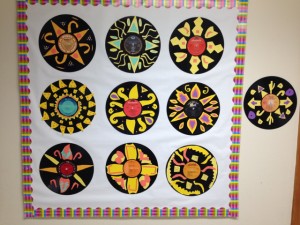 Art
Art
The 4th and 5th graders finished their “Aztec Sun Design Meets Vinyl”. The students did a great job gluing their shapes in a symmetrical pattern around the label of a 33 record. Stop and see these Very Vintage designs which are on the bulletin board by the boys restroom.
Music
We listened to several examples of Cuban music that Sr. Kit recorded on his recent trip, and learned a bit about the school’s new percussion instruments. We also talked about the history of Cuba since his precious visit in 1958, and some of the people he met there.
by Sarah Segall | Oct 24, 2015 | In The Loop
Language Arts
We had a full week! Here are a few areas of focus from our Language Arts studies this week:
- We had another lesson and activity on helping verbs, understanding what they are, how they work, and how to identify them.
- We learned about different types of sentences (declaritive, questions, exclamations, and commands)
- We worked on identifying the main idea of paragraphs.
- We worked on our cursive undercurve (I, B, G, S), overcurve (n,v, I, Q), downcurve (a,d,C,O), and slant (t,p,B,R).
- We completed our first Unit: Amistad. We will take our end of the unit assessment on Monday.
- We completed the writing process for our autobiographies. These can now be viewed on our hallway display.
Spelling/ ortografia(plurals of Z words – Spelling test Tuesday, October 27th.)
- tapices
- lápiz
- lápices
- arroz
- arroces
- veloz
- voloces
- voz
- voces
- luz
- luzes
- nariz
- narices
- vez
- veces
Math
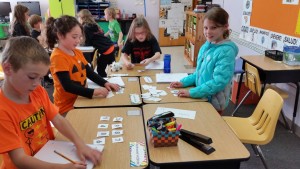
The students learned a new game: el juego del menor diferencia. Ask them how to play.
This week began our unit on Subtraction up to 10,000. We had great fun reviewing methods we have learned in the past. (We still have our cute saying from when borrowing was first introduced:–Oh decenas, decenas, ¿Puedo tener una decena por favor? ¡Sí, claro que si!– But now we need to borrow from las centenas/ hundreds and los millares/thousands.)
On Friday we completed lesson 4.4, borrowing across zeros. It was great fun to use the sticky-note dates each student brought in. We compared numbers and subtracted to figure out the differences. The birth of our nation occurred 232 years before Spencer’s birth! These numbers provided great practice borrowing across zeros.
Students were given an assignment this weekend to calculate the difference in ages of everyone in the family, using birth years. They should bring this to class on Monday.
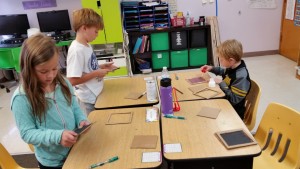 Social Studies
Social Studies
We learned lots about the Roman daily life and architecture this week. We learned how brutal and chaotic life could be there at times and how surprisingly sophisticated the infrastructure was. We talked more about what education for the boys and girls entailed; history and language for all but only music for girls and physical education for the boys. We also looked at what rights women had; they could own property, be landlords, loan money but couldn’t vote. We had so much fun on Friday making our own Roman writing tablets. These will come home next week after we finish decorating and painting them. On Friday we also took a short quiz on the Punic Wars.
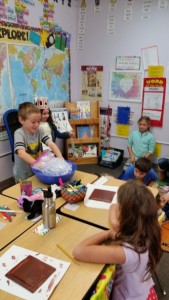 Science
Science
We learned all about mammals this week, finally a group we can relate to! We read about how mammals have live births, mammary glands, and either fur or hair. We learned that most mammals are terrestrial, though some are aquatic and semi-aquatic. By far the class favorite mammal was the pattern breaker; the Platypus. You just have to love this crazy creature! We talked about the purpose of hair and fur, and how some mammals have very little hair or fur but have blubber. The class was fascinated by the idea of blubber so on Friday we did a blubber mitten experiment, this was a big hit. Pleas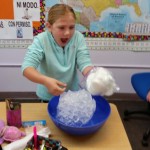 e ask your kiddo about this, all I can say is that I now have Crisco living in my cupboard at home. We have also started the rough draft of our Animal classification paragraphs. The students picked one animal and are pulling information from the webbing sheets they have done, the classification chart that we have been filling in and research from class books and the web. We will be working on these for the next week. On Friday we read about Animals from around the world.
e ask your kiddo about this, all I can say is that I now have Crisco living in my cupboard at home. We have also started the rough draft of our Animal classification paragraphs. The students picked one animal and are pulling information from the webbing sheets they have done, the classification chart that we have been filling in and research from class books and the web. We will be working on these for the next week. On Friday we read about Animals from around the world.
English Spelling/Writing
I have to say I have been so impressed with how responsible and efficient this class is. They come in each morning and go right to work, writing in their planners and then immediately tackling spelling. They choose their activities they want to do for the week, calculate their points and go for it. Most students finish an activity in the allotted time and then work on their journals. Each week I see a general improvement in spelling scores. Good job everyone! We reviewed pronouns and nouns this week, I challenged the class with an alliteration activity to help them with their nouns. They were good sports about it, as it was not an easy task. Our journal topics this week were to finish our myth story and to write about what it would be like to go back in time and visit Rome. Students were to compare and contrast their own culture to that of Ancient Rome.
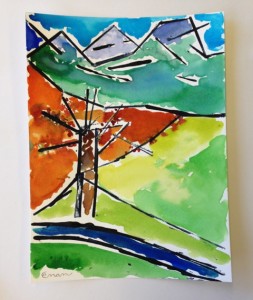 Art
Art
We talked about the background, middle ground, and foreground in landscapes. We compared a realistic landscape by an American painter, Thomas Cole, and a more abstract landscape by the French painter Cezanne. Hazel noted that the shapes in Cezanne’s landscape resembled tiles, similar to the mosaics that the students made last week. The students used cardboard scraps to “stamp” the black outline of mountains, fields and a tree, then added watercolor. I will put these beautiful landscapes on a bulletin board next week.
Music
Señor Kit played several examples of Cuban music that he videotaped on his recent trip to Cuba. We then checked out each of the seven types of instruments from Cuba that have been added to the school’s collection, with each student playing rhythmic passages on two or more of the instruments.
by Sarah Segall | Oct 24, 2015 | In The Loop
Language Arts
We completed our Sombras unit this week with a fantasy story: Nada se pega como una sombra. Here is a brief highlight of things we worked on this week:
- word length
- Punctuation marks
- Capital letters
- Comprehension: monitoring and clarifying meaning during reading, making connections
- Vocabulary: classification or different kinds of words
- Writing: telling how many laps were run in the Pumpkin Fun Run and comparing with classmates.
- ABC order
We worked with the letters: Z (which makes an /s/ sound in Spanish), R, H, J (the letter H is silent in Spanish while the letter J makes the /h/ sound.)
Our high-frequency words this week were: Si, no, hay (there is / there are), veo (I see). The students have been working with these words on a daily basis, completing a worksheet for practice, using them in oral sentences, reading them on our word wall, and reading them in our word pathway.
Math
We had fun comparing numbers, working on number identification, counting on, and forming groups of 5 and groups of 10.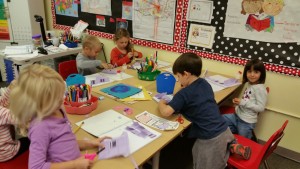 We completed a few activities in our interactive math journals where students showed how many were missing to form 5 and 10. These activities are great for counting on but also for cutting, glueing (yes, this is a BIG skill), keeping track of small pieces, planning and organization of pieces in their layout.
We completed a few activities in our interactive math journals where students showed how many were missing to form 5 and 10. These activities are great for counting on but also for cutting, glueing (yes, this is a BIG skill), keeping track of small pieces, planning and organization of pieces in their layout.
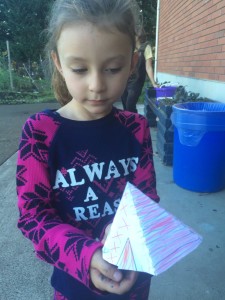 Social Studies & Science
Social Studies & Science
This week we continued our unit on Native Americans. We are learning about the Sioux tribe. We have learned where the Sioux lived, and the importance of buffalo to the tribe. See if your child can tell you several things the Sioux made from buffalo (clothing, moccasins, meat, shelter etc.). We learned about the training young boys would go through to become a Sioux warrior that would hunt the buffalo. We learned that the Sioux were nomadic tribe moving from a summer camp to a winter camp each year.
Music
Our new percussion instruments from Cuba were the focus of this week’s lesson. We also listened to some Cuban music and saw how the sounds could be reproduced on these instruments. The class especially enjoyed figuring out what the instruments were made of and how hollow spaces relate to how much sound a given instrument makes.
Art
The kindergarteners learned how to draw an owl this week. We went through the lesson step by step, and they did an excellent job following directions! They used basic shapes (circles, triangles) and letter shapes (U for the body, W for the feet) to draw their owls using oil pastels. We put all the owls on the whiteboard and enjoyed seeing the individual creativity of each student.
by Sarah Segall | Oct 23, 2015 | In The Loop, Preschool
Our next Scholastic book order is due this Monday, October 26th. All orders should be done online.
- VISIT scholastic.com/readingclub
- ENTER the one-time Class Activation Code H2CQB
- SHOP from a carefully curated selection of the best books, value packs, and Storia eBooks
- SUBMIT your order and earn FREE Books for our classroom
- All book orders will be shipped to our classroom so we can celebrate the joy of reading together!
by Sarah Segall | Oct 17, 2015 | In The Loop
Language Arts
We had another busy week in literacy. In grammar, syntax and word studies we worked on identifying simple sentences (subject/object). We also worked on vocabulary (words with multiples meanings) and prefixes i- , in- (irreparable, intacto). We also spent time listening to Amalia grandmother’s favorite song: Gracias a la vida, by Violeta Parra. Violeta Parra is considered one of the most influential Chilean songwriters- singers and is an icon in Latin-American folk music.
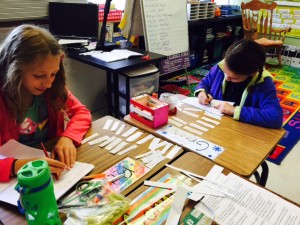 On Thursday we finished reading our book Con carino Amalia. Once again, students have done such a remarkable job staying on track with our reading schedule and also maintaining accurate records of their reading. During this project, the main goals for our students are to be able to:
On Thursday we finished reading our book Con carino Amalia. Once again, students have done such a remarkable job staying on track with our reading schedule and also maintaining accurate records of their reading. During this project, the main goals for our students are to be able to:
- Identify the key elements in the story and demonstrate understanding of the main message(s).
- Describe characters, settings, important events. Summarize making a distinction between main ideas/events and supporting details.
- Check for understanding asking questions and clarifying their questions.
- Compare and contrasts elements of the story.
- Explain their thinking and share ideas, connections and inferences with others.
Next week, we will continue to discuss our understanding of the story and will be working on our book portfolio. They will also have time to reflect on their work to self-assess their work. On Friday, portfolios need to be submitted. After that, we will be having a culminating celebration.
Math
Students were hard at work all week mastering the algorithm of 2-digit by 2-digit multiplication equations. We spent some time on ALEKS, played a dice game in groups, as well as enjoyed a culminating activity to exhibit mastery called “birds of a feather”. Some students insisted on bringing this home to finish over the weekend, they were so engaged!
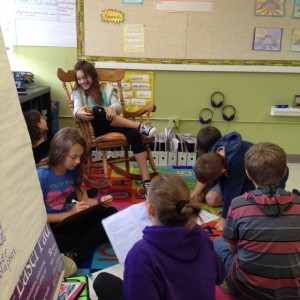 Social Studies
Social Studies
This week we started a new unit on the Renaissance and Reformation. Students have done well learning several vocabulary words for this important historical time. In addition, we learned an excerpt from William Shakespeare’s “A Midsummer Night’s dream” for our weekly poem study. More kids than ever before chose to memorize and recite their poems this past week. It was so fun to see! Next week we will take a look at another of Shakespeare’s works as he was such an instrumental figure of the Renaissance age.
Science
This week we spent time reviewing concepts of our first investigation and checking for understanding. 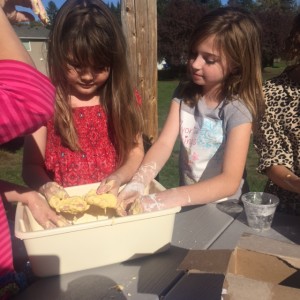 We played a fun true or false game which students rocked! We also had a hands on activity where students made a mixture of Maicena and agua. This was a great opportunity to review vocabulary as well. We saved our dough to introduce some ideas for our upcoming investigations. There is a very interesting process that happens when mixtures start to smell! next week will start our second investigation: Reaching Saturation. If your child wants to get ahead of the game, they were asked to brainstorms some ideas and how these word connect. Here there are some key words: saturated solution, solvent, solubility, quantity. Have fun!
We played a fun true or false game which students rocked! We also had a hands on activity where students made a mixture of Maicena and agua. This was a great opportunity to review vocabulary as well. We saved our dough to introduce some ideas for our upcoming investigations. There is a very interesting process that happens when mixtures start to smell! next week will start our second investigation: Reaching Saturation. If your child wants to get ahead of the game, they were asked to brainstorms some ideas and how these word connect. Here there are some key words: saturated solution, solvent, solubility, quantity. Have fun!
Art
In 4th and 5th grade art we looked at the Aztec Calendar or Sun Stone, and talked about sun designs used by Aztecs, Mayan, and Inca people. The students then made a sketch of their own sun design, and created paper patterns that will be glued on old vinyl records (that were free at a thrift store). I’m excited to see how these creative sun designs turn out!
by Sarah Segall | Oct 17, 2015 | In The Loop
Language Arts
We worked on several great skills this week:
- using a dictionary (identifying parts of speech, using alphabetical order, choosing amongst various definitions)
- writing varying sentences within paragraphs to provide more interest to the reader
- comparing and contrasting characters from two different stories, providing examples as proof, and citing our source (title and page number)
- peer editing our autobiographies
- publication (typing) for our autobiographies
- putting accents in our autobiographies, using special characters on the computer
- recitation of a fall poem
We began a new class accountability chart. Students will receive a start on the chart for each week they turn in every completed assignment on time. Students will receive a special reward for every 4 stars they receive.
There are no Spanish spelling words for this week but students should be reading book #4 (and any others they are interested in) and completing their “Reading with a purpose” worksheet. This worksheet is due Monday.
Math
We breezed through addition to the thousands, with and without regrouping. We had fun playing our suma mil game again. All students were asked to work on the addition portion of the ALEKS pie during the past two weeks. We took our unit test on Friday and everyone did a fantastic job!
We will begin our subtraction unit on Monday. Students should begin working through the subtraction portion of ALEKS. Also, students will receive their new homework packet on Monday. This will be due 10/30. (Please note: we are asking students to show their work. It is easier to understand where a mistake is made if we can see the process/work. Also, being able to pick apart our math now, while it’s simpler, will help us to better understand and explain our math strategies when they become more complex. Students should show all their work.)
Social Studies
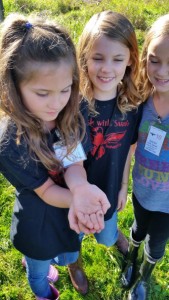 On Monday we learned about the Punic Wars; who was involved in them and how they lasted for more than one hundred years. Students identified some key locations on a map such as the area that was once Carthage (Tunisia in Africa), Sicily in Italy, Spain and the Italian Alps and then marked them on our classes’ Living Map. We read about the Carthaginian general, Hannibal, who led a huge army and “monsters” (elephants) across the frozen Alps to battle the Romans. Thursday the class wrote about what the Romans gained from the Punic wars; the newly controlled Mediterranean area of North Africa and Spain. They also sequenced major events that happened during the wars and added Punic Wars to their timelines. On Friday we began reading about how the beginning of the Roman Empire affected aspects of the daily life of Romans: housing, education, work, imports and trade, art, and entertainment. We also learned about the ingenious aqueduct, which was another contribution that came from the ancient Roman civilization. We added this to our civilization chart under contributions to the modern world.
On Monday we learned about the Punic Wars; who was involved in them and how they lasted for more than one hundred years. Students identified some key locations on a map such as the area that was once Carthage (Tunisia in Africa), Sicily in Italy, Spain and the Italian Alps and then marked them on our classes’ Living Map. We read about the Carthaginian general, Hannibal, who led a huge army and “monsters” (elephants) across the frozen Alps to battle the Romans. Thursday the class wrote about what the Romans gained from the Punic wars; the newly controlled Mediterranean area of North Africa and Spain. They also sequenced major events that happened during the wars and added Punic Wars to their timelines. On Friday we began reading about how the beginning of the Roman Empire affected aspects of the daily life of Romans: housing, education, work, imports and trade, art, and entertainment. We also learned about the ingenious aqueduct, which was another contribution that came from the ancient Roman civilization. We added this to our civilization chart under contributions to the modern world.
Science
We had such a wonderful field trip this week to Zenger farm. I am so glad that Miss Jill found this gem. The class got to see and do so much. We particularly seemed to enjoy our visit to the wetlands and exploring this habitat. I loved watching the enthusiasm students had when they were able to gather specimens from the stream with their nets and then get a close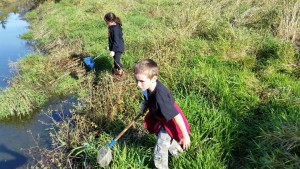 r look at them in the magnifying containers. Thank you to all the parents who joined us for the trip, I hope you found it as worthwhile as I did.
r look at them in the magnifying containers. Thank you to all the parents who joined us for the trip, I hope you found it as worthwhile as I did.
We continued our lesson on Birds this week and added what we learned to our classification chart. Students reviewed what they had read last week and wrote summary notes. They filled in a webbing sheet on all the important characteristics of birds and chose one bird to draw a picture of. On Friday we had fun doing an experiment on why birds beaks are different and how they help them eat a variety of food. We then filled in a graph with the data we collected.
English Spelling/Writing
The class had an extra week to work on their spelling activities and study for their test. I’m sure everyone did fabulous! Starting next week we will have less time to do spelling homework in class in order to have more time for journal writing. So I encourage students to do a little spelling each day at home. To help with this, I will send next weeks sort list home on Friday in the Take Home Folder so students can work on activities over the weekend if they chose to. We also reviewed four types of sentences in writing this week: declarative, interrogative, exclamatory, and imperative.
Art
The 2nd and 3rd graders finished working on their animal mosaics this week. We looked at an ancient Roman mosaic again, and also looked at some modern art mosaics by Chuck Close. The students added a background for their reptile, amphibian or fish. Stop by the bulletin board by the water fountain and check out these great mosaics. Look closely some of the animals are camouflaged!
by Sarah Segall | Oct 17, 2015 | In The Loop
Language Arts
We had such a fun week in language arts! We played Veo, Veo (Eye Spy) this week, which the kids loved. It was especially helpful to need to find objects that start with a certain letter in Spanish. We found out that there are a lot of things around the classroom that begin with the letter A and M, yet there were only a few things that began with the letter K. During reading we reviewed syllables again, as this seems to be very helpful when we write our complete sentences. While reading at home have your child figure out how many syllables are in some of the more complicated words. We did a lot of work this week with high frequency words, making sure that we remember all the ones we learned last year and adding on some new ones as well. This week we worked with the word aunque (although) and según (according to). See if you can get your child to use these sometime this weekend! I know there has been some confusion with the students reading binders. I will be reorganizing the books this weekend so we can be back on track Monday. Thank you for your patience. Have a great weekend!
Math
This week we started our addition facts up to the number 10. The students are recalling addition very easily and I am very confident that we will be able to do much bigger addition facts very soon. Again, we are focusing on counting on when we add. This is a very important skill for all the students to master as it will make algebra easier to understand later. We played a flash card math game in class on Friday with our addition facts up to 10. The kids are already beginning to memorize some common math facts even without any instruction. I also introduced math sentence building. We are working on making sure to have complete math sentences which include 3 numbers (the two we are adding and a result), the operation (in this case addition), and an equals sign. Even though it was a bit confusing the first day to “build sentences” in math the students quickly learned that it is a lot like the sentences we write in Language Arts. Continue working at home with simple addition facts. We will be doing math story problems next week, so if you happen across some addition at home make sure to talk about it!
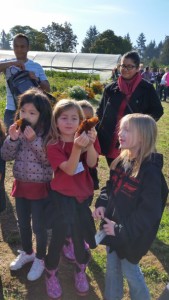 Social Studies & Science
Social Studies & Science
What a fabulous field trip to Zenger farm this week. Thank you to all the parents that powered through the traffic to get their kiddos there and for joining us on our adventure. Thanks to Miss Jill too, for finding this wonderful gem. The students had so much fun learning about animals and plants on the farm, they even got to taste a few things. They also seemed to enjoy getting their hands dirty and helping out with the farm work. In class we made a word bank with all the things we learned on the farm, breaking it down into plants, animals, and habitats. We used these lists to help us write in our journals and make a class book titled Down By Zenger Farm.
We continued to learn about the rain forest this week. Students got to finish their mini book that they began with Miss Jennie last week and then practiced reading it in class on Tuesday. We have been observing how our classes’ mini rain forest seems to be making its own “rain”. Students noticed that there is condensation on the inside of the container and
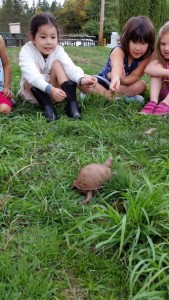
water is dripping off the plants. We read several books about the rain forest this week, the students compared and contrasted the books. The students got a special treat of observing some visiting turtle, Atticus and Einstein, in their mini habitat. We even had a chance to do a turtle race with the kindergartners.
In Social Studies this week we were finishing up our lesson about people of the Nile and how they communicated through writing in the form of hieroglyphics. Next week the class will get a chance to do some of their own Egyptian writing. We added hieroglyphics and farming to our civilization chart and compared these to the Mesopotamian farming and cuneiform.
English Spelling
On Thursday the class got their new sorts. They only had time to do one sort activity each day in order to allow us time to make our class book and do our journal writing. We will spend more time with this sort next week. I sent a copy of the sort list home on Thursday in their Take Home Folders.
Art
The first graders finished their Egyptian collars this week in art. We looked at examples of Ancient Egyptian jewelry again and noticed their colors and patterns. Then the students used cut paper, glitter, and “rhinestones” to decorate their collars. Next week I’ll take a picture of the students wearing these very creative Egyptian collars!
by Sarah Segall | Oct 17, 2015 | In The Loop
Language Arts
We read a great short story, El lobo y su sombra, about a wolf who sees how big his shadow is and decides he’s the biggest animal out there. This provided the class a wonderful opportunity to discuss why and when our shadows changes size and shape. We illustrated and wrote (dictated) about this in class.
Students were put into reading groups last week and worked well within their groups this week. We are still working on ‘following along’ while listening to someone else read.
In our short week we were able to focus on the letters: ñ, x and w . We also worked with the high-frequency words: él (he), de (of, from), and del (of the, from the)
Math
We worked on number and number word identification. Students matched tens frames to groups of objects to written numbers. Students also worked on using data to construct graphs. We had a taste-testing of three different kinds of apples. Students then chose their favorites, recorded this, and then went around to collect the data from their classmates. (This was great practice with their tallies.) They then used this data to create a bar graph.
Social Studies & Science
I hope you enjoyed our field trip to Zenger Farms as much as I did! I think we all had some information that we learned in our “Plants” unit reviewed and I know we all learned some new information as well! What fun! Zenger Farms does not disappoint!
This week we were introduced to our new Social Studies unit: Native Americans. We will be learning about different Native American tribes and the way they lived long ago. We learned that there are many tribes in many different regions of the country. We will be focusing on the Sioux and the Great Plains. We will be comparing how they lived, what they wore and ate, and what their homes were like.
We learned about the environment in which the Sioux lived, that the Sioux were a nomadic tribe, the food, clothing and shelter of the Sioux and the importance of the buffalo to the Sioux
If you get a chance, the Ridgefield Wildlife reserve has a replica of a longhouse on it’s grounds. It would be a great supplemental learning experience! http://ridgefieldfriends.org/
As always, if you have a book or artifact that pertains to what we are learning, please feel free to send it in. In addition, if any of our units happens to be an area of expertise of yours, we would love to have you come in and share your knowledge with us. It takes a village!
Art
This week the kindergarteners painted their Fence Post portraits for the picket fence, which Sarah is planning for the garden at school. I had the pattern drawn on the wood for the children, and then they painted the face and the clothing. We had lots of help from the 4th and 5th graders, Sarah, and Stacy (Alora’s mom). The kindergarteners did a great job!
by Sarah Segall | Oct 16, 2015 | Preschool
El Tacto
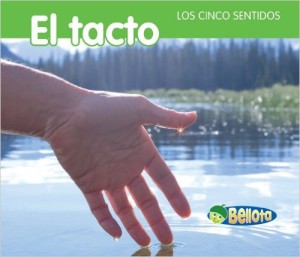 This week was all about touch / el tacto. We read about different ways we use el tacto, but mainly the students thought we were playing! It is very fun to be hands on, literally.
This week was all about touch / el tacto. We read about different ways we use el tacto, but mainly the students thought we were playing! It is very fun to be hands on, literally.
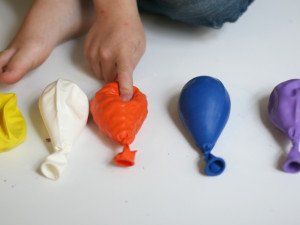
The students had a great time getting messy, digging their hands into bags in order to guess the objects using only their sense of touch.
Another activity was for them to guess what was inside each of these balloons using only their sense of touch and their prior experiences.
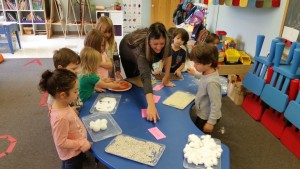 This week we learned all about the letter O and the number 4. Be sure to point out the letter O when you are reading (or if any family members have this letter in their name). The English pronunciation of this letter ends with a /w/ sounds. The Spanish pronunciation stops with just the /o/ sound (no lip movements during the making of any Spanish vowels).
This week we learned all about the letter O and the number 4. Be sure to point out the letter O when you are reading (or if any family members have this letter in their name). The English pronunciation of this letter ends with a /w/ sounds. The Spanish pronunciation stops with just the /o/ sound (no lip movements during the making of any Spanish vowels).
We incorporated our touch investigations with our letter study and made many different letter O’s. Ask your child to find certain textures on the O and then to find something with a similar texture around the house or outside.
 f a set of glasses using only their sense of smell/ el olfato.
f a set of glasses using only their sense of smell/ el olfato.










 We completed a few activities in our interactive math journals where students showed how many were missing to form 5 and 10. These activities are great for counting on but also for cutting, glueing (yes, this is a BIG skill), keeping track of small pieces, planning and organization of pieces in their layout.
We completed a few activities in our interactive math journals where students showed how many were missing to form 5 and 10. These activities are great for counting on but also for cutting, glueing (yes, this is a BIG skill), keeping track of small pieces, planning and organization of pieces in their layout.




 r look at them in the magnifying containers. Thank you to all the parents who joined us for the trip, I hope you found it as worthwhile as I did.
r look at them in the magnifying containers. Thank you to all the parents who joined us for the trip, I hope you found it as worthwhile as I did.



